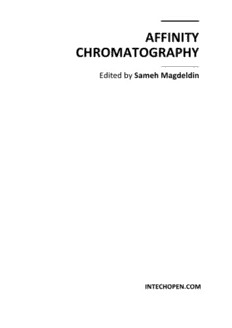
Affinity chromatography PDF
Preview Affinity chromatography
AFFINITY CHROMATOGRAPHY Edited by Sameh Magdeldin Affinity Chromatography Edited by Sameh Magdeldin Published by InTech Janeza Trdine 9, 51000 Rijeka, Croatia Copyright © 2012 InTech All chapters are Open Access distributed under the Creative Commons Attribution 3.0 license, which allows users to download, copy and build upon published articles even for commercial purposes, as long as the author and publisher are properly credited, which ensures maximum dissemination and a wider impact of our publications. After this work has been published by InTech, authors have the right to republish it, in whole or part, in any publication of which they are the author, and to make other personal use of the work. Any republication, referencing or personal use of the work must explicitly identify the original source. As for readers, this license allows users to download, copy and build upon published chapters even for commercial purposes, as long as the author and publisher are properly credited, which ensures maximum dissemination and a wider impact of our publications. Notice Statements and opinions expressed in the chapters are these of the individual contributors and not necessarily those of the editors or publisher. No responsibility is accepted for the accuracy of information contained in the published chapters. The publisher assumes no responsibility for any damage or injury to persons or property arising out of the use of any materials, instructions, methods or ideas contained in the book. Publishing Process Manager Bojan Rafaj Technical Editor Teodora Smiljanic Cover Designer InTech Design Team First published March, 2012 Printed in Croatia A free online edition of this book is available at www.intechopen.com Additional hard copies can be obtained from [email protected] Affinity Chromatography, Edited by Sameh Magdeldin p. cm. ISBN 978-953-51-0325-7 Contents Preface IX Part 1 Principles and Applications of Affinity Chromatography 1 Chapter 1 Affinity Chromatography: Principles and Applications 3 Sameh Magdeldin and Annette Moser Chapter 2 Affinity Interactions as a Tool for Protein Immobilization 29 Eva Benešová and Blanka Králová Part 2 Lectin Affinity Chromatography 47 Chapter 3 Affinity Chromatography of Lectins 49 Jure Pohleven, Borut Štrukelj and Janko Kos Chapter 4 The Difference of Lectin Recovery by Sugar-Bound Resin 75 Mitsuru Jimbo, Shin Satoh, Hirofumi Hasegawa, Hiroshi Miyake, Takao Yoshida, Tadashi Maruyama and Hisao Kamiya Part 3 Immunoaffinity Purification 89 Chapter 5 Immunoaffinity Chromatography: A Review 91 Daad A. Abi-Ghanem and Luc R. Berghman Chapter 6 Affinity Chromatography for Purification of IgG from Human Plasma 107 Lucia Hofbauer, Leopold Bruckschwaiger, Harald Arno Butterweck and Wolfgang Teschner Part 4 GST – Tagged Affinity Chromatography 125 Chapter 7 A Study of the Glutathione Transferase Proteome of Drosophila melanogaster: Use of S- Substituted Glutathiones as Affinity Ligands 127 Ramavati Pal, Milana Blakemore, Michelle Ding and Alan G. Clark VI Contents Part 5 Nucleic Acids Affinity Purification 143 Chapter 8 RNA Affinity Chromatography 145 Nehal Thakor and Martin Holcik Part 6 Immobilized Metallic Ion Affinity Chromatography (IMAC) 165 Chapter 9 Ion Metallic Affinity Chromatography and Purification of Bacterial Toxin 167 Luciano Moura Martins and Tomomasa Yano Part 7 Usage of Affinity Chromatography in Purification of Proteases, Protease Inhibitors, and Other Enzymes 175 Chapter 10 Polyhistidine Affinity Chromatography for Purification and Biochemical Analysis of Fungal Cell Wall-Degrading Enzymes 177 Takumi Takeda Chapter 11 Novel Detection Methods Used in Conjunction with Affinity Chromatography for the Identification and Purification of Hydrolytic Enzymes or Enzyme Inhibitors from Insects and Plants 187 Alexander V. Konarev and Alison Lovegrove Chapter 12 Affinity Chromatography as a Key Tool to Purify Protein Protease Inhibitors from Plants 211 Elizeu Antunes dos Santos, Adeliana Silva de Oliveira, Luciana Maria Araújo Rabêlo, Adriana Ferreira Uchôa and Ana Heloneida Araújo Morais Chapter 13 Identification of cGMP-Kinase Complexes by Affinity Chromatography 255 Salb Katharina, Schinner Elisabeth and Schlossmann Jens Part 8 Affinity Chromatography as a Quantitative Tool 273 Chapter 14 Affinity Chromatography as a Tool for Quantification of Interactions Between Drug Molecules and Their Protein Targets 275 Piotr Draczkowski, Dariusz Matosiuk and Krzysztof Jozwiak Contents VII Part 9 Practical Application of Affinity Chromatography in Research Field 305 Chapter 15 The Value of Fungal Protease Inhibitors in Affinity Chromatography 307 Jerica Sabotič, Katarina Koruza, Boštjan Gabor, Matjaž Peterka, Miloš Barut, Janko Kos and Jože Brzin Chapter 16 Affinity-Based Methods for the Separation of Parasite Proteins 333 C.R. Alves, F.S. Silva, F.O. Oliveira Jr, B.A.S. Pereira, F.A. Pires and M.C.S. Pereira Chapter 17 Soluble Expression and Purification of Histidine-Tagged Moloney Murine Leukemia Virus Reverse Transcriptase by Ni-NTA Affinity Chromatography 357 Xie Fei, Ma Xuemei and Wang Xiansong Preface With the huge number of books and publications that utilizes different aspects of affinity chromatography, it is still hard to find a freely accessed book that gathers a solid and concise understanding of affinity principles together with its applications in a single volume. The vision of this book is not more than an attempt to provide an open source single volume demonstrating the concept of affinity chromatography with some of its applications that meets the current throughput screening demands of scientists and researchers. This book “Affinity chromatography” starts with introductory chapter that passes through the basic principles and snapshot applications of this analytical technique, followed by a wide ranged practical research chapters utilizing affinity chromatography, written by leading experts worldwide. It is worthy to say that the scope of the information contained in this book is still limited to be covered in a single volume. Affinity chromatography is aimed mainly at those interested in different analytical and separation techniques, particularly, biochemists, biologists, pharmacists, advanced graduate students and post graduate researchers. Finally, I am grateful to the all experts who showed positive and specific “affinity“to participate and share in this book with their valuable experience. Indeed, without their participation, this book won’t come to light. Sameh Magdeldin, Ph.D Senior Post Doc Researcher and Proteomics Team Leader Medical School, Niigata University, Japan Ass. Prof. (Lecturer), Physiology Dept. Suez Canal University, Egypt
